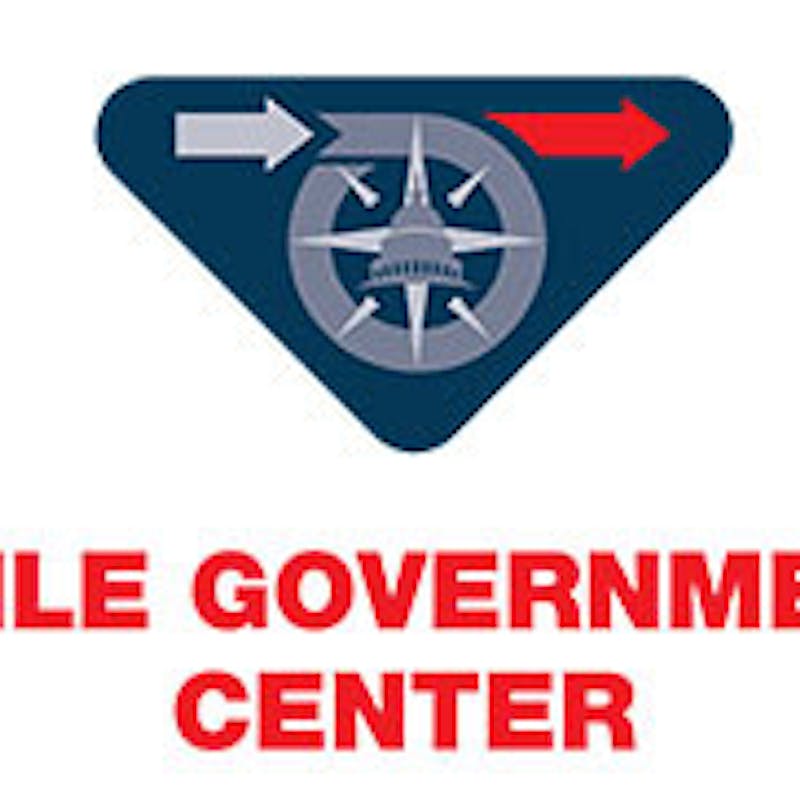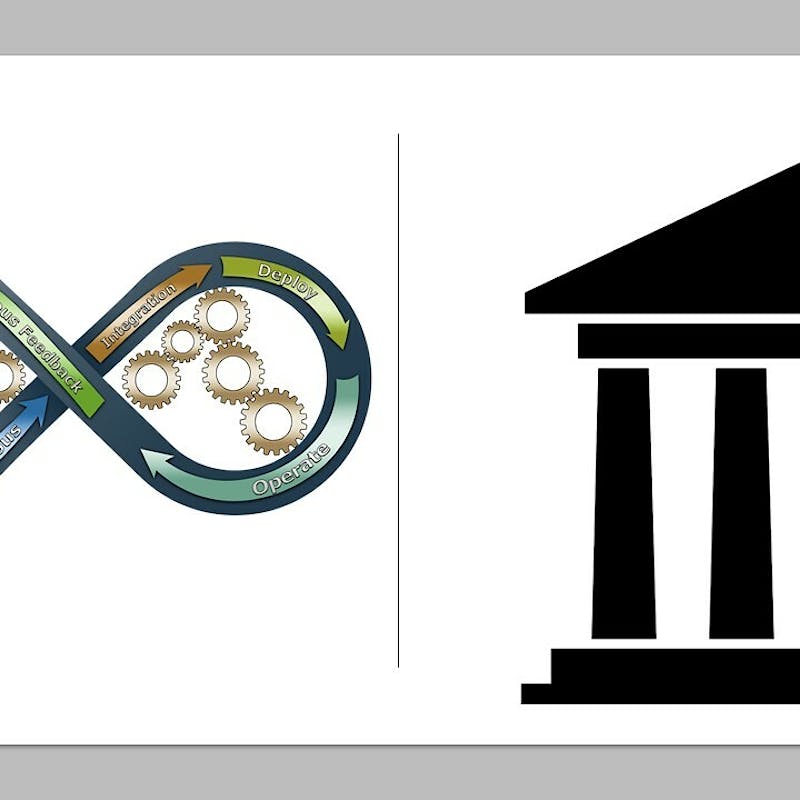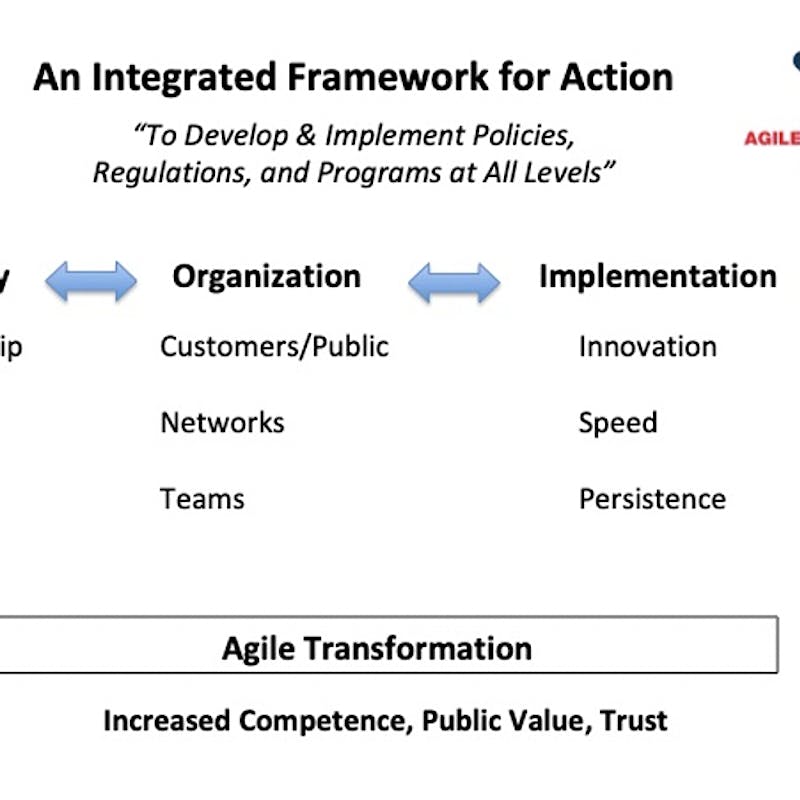The Future of Agile Government
By: G. Edward DeSeve
In this report, Ed DeSeve builds on his prior work as leader for the Agile Government Center (AGC) to expand how agile principles can apply to the development and implementation of government policies, regulations, and programs. The author introduces the “Integrated Agile Framework for Action”, to guide government leaders and stakeholders in implementing agile strategies in their work to provide services to the public in a way that fosters public trust. DeSeve concludes with multiple recommendations for government leaders and agile innovators, including:
- Agile leaders at all levels need an agile mindset. This means a willingness to try new ideas and processes to achieve better results.
- Government needs intentional leadership development strategies. Equipping leaders at all levels via a common approach to agile principles drives successful transformation.
- Integration is critical to execution. The elements described in the framework are designed to work together.
- Leaders at all levels need to analyze and understand trust in and across their organization. Trust is key for populations including employees, the public, and partners.
- Agile government must begin with understanding customers. Analyzing the customer experience and journey starts with understanding who the customers are, how their journey with the organization flows, what constitutes “defining moments” in their experience, and continuous monitoring of customer views.
- Public values must be respected and the public must be engaged. These values include a focus on openness, integrity, and fairness, which can improve overall trust
- Networks should form the default development and implementation pathway wherever possible. Collaborative networks can be internal, external, international, or some combination of these, and should serve as a force multiplier for mission execution.
- Cross-functional teams should drive integrated solutions to problems. Cross-functional teams bring more perspectives and encourage diversity of thought in creating and executing new solutions, greatly enhancing the chances for success.
- Appropriate speed and persistent iteration will enable the organization to shape and reshape successful approaches. Setting aggressive deadlines to accomplish work and demonstrate continual achievement builds internal and external support.
- Simultaneous execution of agile government actions is required. Agile government is not a sequential process, but rather an integrated series of actions designed to increase organizational competence while respecting public values.
The report builds on the considerable body of work released through the AGC since its creation three years ago. The AGC serves as the hub of a network that brings together governments, nonprofits, foundations, academic institutions, and private sector partners to assist in developing and disseminating agile government principles and case studies of agile policies and programs. This global network provides support for those who want to adopt and implement agile principles to provide public goods and services that fully meet customer needs and build public trust, and to identify cases of effective agile government in practice. DeSeve outlines many such cases in this new report.

The 5 A’s of Agile Government Performance and Tools for Adoption
By: Robert Shea
The 5 A’s of Agile Government Performance and Tools for Adoption “Agile” is a management practice that emphasizes evidence, customer-orientation, incremental improvement, and speed. What does agile mean when talking about government performance? Agile governments use evidence, metrics, and other data to extract insights that help them and others improve the state of the world. Agile governments use and communicate evidence, metrics, and other data to improve performance on three dimensions: outcomes, operations, and trust....Learn More

The Agile-Policymaking Frontier
By Larry A. Rosenthal, Goldman School of Public Policy, UC Berkeley Just the sound of “making government more agile” summons pleasing images to the civic mind: resilient response to changing conditions; innovation and ingenuity; immediacy in problem-solving; citizen-centered service; bureaucracy getting out of the way; experimentation leading to progress. ...Learn More
Agile Leadership
By: G. Edward DeSeve
This blog is the third in a series based on the Integrated Framework for Action, described below. The AGC continues to refine the Framework and the Principles on which it is based and would be pleased to receive comments, questions and suggestions for improvement. Comments can be sent to agilegov@napawash.org
Defining Leadership
The study of leadership has deep and abiding pathways that cannot be quickly summarized. My own study of leadership has been influenced by the seminal work of James MacGregor Burns. In his 1971 book, “Leadership,” Burns distinguished between transactional and transformational leadership. The first is the everyday task of guiding of an organization in going about its assigned functions. It may include some give and take, some compromises, and even finding solutions to roadblocks.
However, Burns distinguishes this from transformational leadership which he says, “cuts more profoundly. It is “to cause a metamorphosis in form or structure.” To use an old analogy, transactional leadership may be making the trains run on time but transformational leadership enabled completion of the Intercontinental Railway which reduced the time it took to cross the nation from four months to four days.
Agile Regulation Gateway to the Future: A New Framework
By: G. Edward DeSeve
The pace, process, and outcome of government regulation is an important ingredient in improving the economic welfare of the world.
To address this problem, the Agile Government Center, led by the National Academy of Public Administration in partnership with the IBM Center for the Business of Government, published its latest major report, “Agile Regulation: Gateway to the Future.” This report is intended for both U.S. regulatory agencies and the regulated public. The report will help agencies keep up with new demands by adopting Agile practices to increase stakeholder satisfaction, allow for more iteration on outputs to learn lessons about what works best, empower staff members, and maximize team and network performance, meet critical public needs, and improve trust in government.

The Integrated Framework for Action
By: G. Edward DeSeve
The Agile Government Framework as presented below contains four “Modules” (Strategy, Organization, Implementation and Transformation) and emphasizes the use of the Agile Government Principles to achieve transformation in the way that governments produce public value by implementing better policies, regulations, and operations.
Several things make the Framework useful in moving toward action in Agile Government:
- Scope: All major activities of government – regulations, policies and programs at all levels of government – are included.
- Clarity of Purpose: Agile Government is intended to be transformational – radically improving competence increasing public value and trust.
- Strategic Approach: Strategy “links aspirations and capabilities” (as John Bryson suggests.)
- Principles-Based: The Framework is supported by 10 underlying Principles (shown in the graphic above) that are evolving—in a truly agile fashion—as more useful information is developed and incorporated.
- Tested using Stories and Cases: The Agile Government Center has developed—and continues to solicit—examples of governments using agile techniques to achieve mission results. We have found that some governments consciously use Agile Principles, while others achieve their success without explicit reference to the Principles.
- Evolving, Not Static: The graphic above will change as we receive comments for how it can be improved.

AGC Series: Educating Agile Leaders
By: Angela Evans
The Agile Government Center (AGC) and its community of interested leaders, the Agile Government Network (action network) are building upon the Academy’s initial efforts as presented in two Academy reports: Building an Agile Federal Government: A Call to Action and the report entitled the Road to Agile Government. The network is committed to advancing the value and practice of agility in public governance through research, global engagement, and academic program content.
The curriculum and pedagogy of schools of public affairs are central in this quest. This series of posts is intended to initiate a dialog on how to integrate agile governance principles into curricula -- with the hope that collaboration among NAPA, Network of Schools of Public Policy, Affairs, and Administration (NASPAA), the American Society of Public Administration (ASPA), and schools of public affairs 1 will result in the steady flow of public servants who embrace the principles of agile government, and who also demonstrate the associated skills and capacity to act on these principles in their day-to-day work.
Agile Government Why Now: An Introduction
Agile Government: Foundational Skills
Accelerating Government with ACT-IAC: Agile Government
From the Federal News Network:
"In this episode, we explore a topic that’s gaining a lot of attention: Agile government. The term “agile” has gained popularity over the years, and while its roots can be found in the agile software development movement, today when we talk about agility, we’ve broadened the aperture considerably. It describes processes that change the very fabric of how the business of government is conducted.
Guests included:
- Casey Coleman, senior vice president for Global Government Solutions at Salesforce and a former General Services Administration CIO.
- Terry Gerton, president and CEO of the National Academy of Public Administration (NAPA) and former senior executive at the Labor Department.
- Dan Chenok, executive director of the IBM Center for The Business of Government and a former Office of Management and Budget executive.
- Ed DeSeve, coordinator of the Agile Government Center at NAPA, Agile Visiting Fellow at the IBM Center for The Business of Government and former deputy director for Management and Controller at OMB."

Former GSA CIO: It's Time for a Federal 'Agile First' Strategy
Fedscoop.com: By Dave Nyczepir
Government should prioritize agile methodologies not only in software development but in IT procurement, finance, budgeting and hiring as well, according to a former CIO of the General Services Administration.
Tasks should be done in parallel rather than sequentially when possible, and paper-based processes should not only be digitalized but done in real-time, Casey Coleman told FedScoop.
The federal Cloud First strategy prioritized cloud migration, while the Cloud Smart strategy directed agencies to take advantage of as-a-service offerings. Ensuring adoption of the agile method is a logical next step and a recommendation ACT-IAC made to the Biden administration during the presidential transition.
“If you think about how work gets done on the ground in departments and agencies, we still have old waterfall processes,” said Coleman, now senior vice president with Salesforce. “There’s an opportunity now to think about what we’ve learned in the pandemic and to change the way we operate to Agile First.”

The Promise of Public Interest Technology
By: G. Edward DeSeve
G. Edward DeSeve. Agile Government Center Coordinator and Academy Fellow. Every once in a while, a new book comes across the desk that is fresh and thoughtful enough to make me wish I had written it. Power to the People: The Promise of Public Interest Technology by Tara McGuinness and Hana Schank is such a book. They start with the mantra of Design, Data and Delivery and focus on how governments and institutions can try to solve the world’s hardest problems by applying a process that is remarkably similar to Agile Government. One of the hallmarks of their process is the understanding of, and involvement of, the public in addressing their needs. The case studies that they present take us to places like Rockford, Illinois where Public Interest Technology (PIT) has been used to radically reduce homelessness. This isn’t about massive new systems but rather: “Informed design that places humans at the center of the policy process.” “The use of real time data to identify solutions and establish success metrics.” “Focusing on delivery by using pilots before scaling.” One of the things that caught my attention was the afterword by Anne-Marie Slaughter of New America and Darren Walker of The Ford Foundation. They described the Public Interest Technology University Network (PITUN) which consists of more than 30 major universities. PITUN’s mission is as follows: “Through the development of curricula, research agendas, and experiential learning programs in the public interest technology space, these institutions aim to develop graduates with skills and knowledge at the intersection of technology and policy.” In fact, McGuiness, Schank, Slaughter and Walker describe the beginning of a movement that could have global significance in creating a united approach to solving the wicked problems that society faces. What does all this have to do with Agile Government? I...Learn More

Agile Problem Solving in Government: A Case Study of The Opportunity Project
Across government, agencies face constant and often expanding levels of complexity in delivering on their mission objectives.
Citizen expectations, changing technologies, a mass proliferation of data, and new business processes are among the key external forces that challenge agencies to serve constituents in new ways.
At the same time, growing demands for fast response to problem-solving reduce the time that agencies have for developing strategies that enable them to achieve mission objectives. In recent years, agile development has advanced in both industry and government as a method of designing software that builds functionality in rapid increments that involve both developers and users. Agile methodology is increasingly being used in non-IT efforts as well.
The Opportunity Project (TOP), a program run out of the U.S. Census Bureau at the U.S. Department of Commerce, has for several years served as a catalyst in adapting agile techniques to solve complex agency mission problems, through a process that brings together agencies, industry, and citizens. The Project’s website refers to its goal as “a process for engaging government, communities, and the technology industry to create digital tools that address our greatest challenges as a nation. This process helps to empower people with technology, make government data more accessible and user-friendly, and facilitate cross-sector collaboration to build new digital solutions with open data.”

Agile: A New Way of Governing
By Ines Mergel of the University of Konstanz, Sukumar Ganapati of Florida International University, and Andrew B. Whitford of the University of Georgia
The evolving concept of “agile” has fundamentally changed core aspects of software design, project management, and business operations. The agile approach could also reshape government, public management, and governance in general. In this Viewpoint essay, the authors introduce the modern agile movement, reflect on how it can benefit public administrators, and describe several challenges that managers will face when they are expected to make their organizations more flexible and responsive
An Introduction to the Agile Government Center
Vision - A global network of governments, non-profits, foundations, academic institutions, and their private sector partners who adopt and implement agile government principles to provide goods and services that fully meet customer needs and build public trust.
The Problem - The United States has been beset with significant social, cultural, and technological changes for decades. The public sector has been slow to adapt to these changes and is often in a reactive mode. Against this backdrop, trust in the federal government has been declining for decades. Nearly two-thirds of those polled by the Gallup organization in September 2019 indicated that they had little or no trust in the federal government’s ability to handle domestic problems. By contrast, the public has more confidence in state and local governments, with Gallup finding that 72 percent of U.S. adults have a "great deal" or a "fair amount" of trust in their local government, and 63 percent believe the same about their state government.
Agile Government and Agile Governance: We Need Both
The term “Agile” comes from the world of software development, and its implementation in project management has led to greater success in technology implementation. Building on this success, good government entities around the world have adopted the “Agile” label to promote better government outcomes.
The Agile phenomenon is highlighted in an upcoming article in the Public Administration Review, "Agile: A New Way of Governing." Authors Professor Dr. Ines Mergel, Professor Andrew B. Whitford, and Professor Dr. Sukumar Ganapati write, “A quiet government transformation is already underway with practitioners who are investing heavily in working in agile environments and applying agile approaches from software development to other types of government problems.”
In this post, we explore two uses of Agile - Agile Government and Agile Governance. In actuality, Governance is twofold – internal Governance that supports service delivery, and external Governance of processes that involve actors outside of government who are significant stakeholders in delivering the outcome of important actions. For simplicity, we will define the two as Agile Government (internally focused and involving government taking action to deliver services) and Agile Governance (externally focused and involving multiple parties beyond government officials, all jointly seeking positive outcomes).
Getting to Agile at Scale in the Public Sector
Agile ways of working in government have become a hot topic. But are public sector agencies really going agile? Where and how extensively is agile taking hold? And is it delivering value? These questions continually crop up in our discussions with public sector leaders. To help demystify the topic, BCG conducted a set of interviews and surveys with executives at 23 global, federal, and state public sector institutions in Australia, Germany, Sweden, Switzerland, the UK, and the US. The study revealed a remarkable uptake of agile in the public sector.
- Nine in ten public sector agencies are using agile, nearly half of them for more than two years.
- IT, policymaking, and service delivery are popular places to deploy agile.
- About 40% have at least one division, ranging in size from about 100 to several thousand employees, using agile as its primary way of working, but few have scaled agile across the enterprise.
- Agencies that have adopted agile are delivering services up to 50% faster and improving citizens’ satisfaction by up to 25%.
In short, agile has arrived in the public sector. To keep making progress in adopting agile as its primary way of working, agencies should move beyond practices such as the “daily stand-up” status check-ins, and put in place enablers such as senior leadership support, new funding models, and training.
Transforming How Government Operates: Four Methods of Change
This report highlights how government agencies can use innovative methods and tools to transform operations in a way that meets their missions and better serves their stakeholders.
Many of the problems of government can be solved by technology, but the real roadblock is knowing how to fix the problems citizens experience when they interact with the government. More than anything, government workers who want to innovate government operations and services need new methods and tools to help make better decisions and deliver more effective results.
Such frameworks provide practical pathways to help agencies transform their operations in a way that makes more effective use of resources. Transformation involves changing how people do their work, how processes are built to support faster and more effective service delivery, and how technologies are brought forward in new ways that leverage commercial best practices—all focused on improving mission results for businesses and citizens. While government leaders understand the need to transform in response to 21st-century demands, less is understood about actions they can take to address this imperative.
Defining Agile Government
Following up on the successes of using agile techniques in software development, many leading private sector companies have used agile principles to transform their organizations.
Others have developed guides for agile organizational transformation and are assisting in its implementation. Governments around the world have begun to leverage this progress, similarly adopting agile principles to transform their organizations.
Recently, a colleague asked me, “What is Agile Government?” I didn’t have a concise answer ready. The Box below contains the National Academy of Public Administration’s current definition of Agile Government. In fact, the precise definition of what constitutes Agile Government is currently evolving in many venues around the globe.
A Guide to Critical Success Factors in Agile Delivery
Agile delivery approaches support the federal government’s goals of doing more with less and improving the agency’s ability to manage its budgets and delivery dates.
Many complex IT programs are encumbered by requirements that continually change over long time frames. The results are often cost overruns and schedule delays. As a result, desired mission objectives are not achieved.
Numerous studies and years of implementation experience with software development within complex IT projects provide evidence that Agile approaches, when executed correctly, improve the delivery of software and large system integration projects. For optimal results, Agile approaches must be planned, implemented with discipline, and tailored to the need of the project and the organization.
Seven Drivers Transforming Government
Based on our recent research and perspectives shared by current and former government leaders, this special report identifies seven drivers for transforming government in the years to come.
In 2018, the IBM Center for The Business of Government marks its twentieth year of connecting research to practice in helping to improve government. The IBM Center continues to execute on its ultimate mission: to assist public sector executives and managers in addressing real-world problems with practical ideas and original thinking to improve government. The Center supports leading researchers to identify trends, new ideas, and best practices—crafting actionable approaches that support government decision-makers in addressing mission delivery and management challenges, through strategies and actions that promote efficiency and effectiveness.

Applying Design Thinking To Public Service Delivery
Every day, U.S. government entities interact with millions of citizens to execute their core missions.
Serving the citizenry has always has been a foundation of our government and today, rapidly advancing technological innovations are fundamentally changing citizen expectations. The last best experience that anyone has becomes the minimum expectation for the next experience. With these changing dynamics as a backdrop, organizations must begin to re-imagine how they innovate, operate, and engage with clients, employees, and stakeholders. Design thinking -- described as a human-centered approach to innovation that puts the observation and discovery of often highly-nuanced, even tacit, human needs right at the forefront of the innovation process -- is currently enjoying unprecedented attention from organizations in search of avenues for innovation, both in the public and private sector.